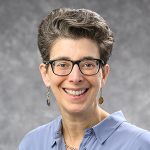
Title: Infants recognize both typical and atypical exemplars for highly familiar words
Legend: 14- to 18-month-old infants were tested on their ability to fixate images of animals after hearing their names. The panel on the left shows the images used, which varied in their typicality. Eye-gaze data, shown in the panel on the right, suggest that infants were equally good at recognizing both typical and atypical exemplars of animals (as evidenced by significant increases in looking to the target image after it is named). These data support the hypothesis that at least some word meanings are already quite broad early in development.
Citation: Weaver, H., Zettersten, M., & Saffran, J. R. (2024). Becoming word meaning experts: Infants’ processing of familiar words in the context of typical and atypical exemplars. Child development, 95(5), e352–e372. https://doi.org/10.1111/cdev.14120
Abstract: How do infants become word meaning experts? This registered report investigated the structure of infants’ early lexical representations by manipulating the typicality of exemplars from familiar animal categories. 14- to 18-month-old infants (N = 84; 51 female; M = 15.7 months; race/ethnicity: 64% White, 8% Asian, 2% Hispanic, 1% Black, and 23% multiple categories; participating 2022–2023) were tested on their ability to recognize typical and atypical category exemplars after hearing familiar basic-level category labels. Infants robustly recognized both typical (d = 0.79, 95% CI [0.54, 1.03]) and atypical (d = 0.70, 95% CI [0.46, 0.94]) exemplars, with no significant difference between typicality conditions (d = 0.14, 95% CI [−0.08, 0.35]). These results support a broad-to-narrow account of infants’ early word meanings. Implications for the role of experience in the development of lexical knowledge are discussed.

Investigator: Jenny Saffran, PhD
About the Lab: The Infant Learning lab studies how infants and young children do such things as: learn language, learn the meanings of words, find the patterns in language and track the properties of speech. Their research focuses on children between 6 months and 5 years of age.
